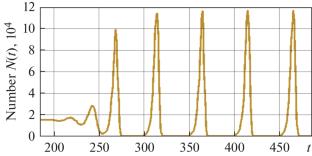包括sars - cov -2株s蛋白结合亲和力指标在新冠病毒模型中的应用
摘要
在分析新型会聚型sars - cov -2病毒株传播情况的基础上,提出了一种新的模拟长期活动极小值后新冠病毒波传播情景的方法。由于定期更新菌株,当前疫情发展的特定变体已被建模为脉动流行过程的版本。开发包含病毒粒子结合指示剂的建模技术与2025年出现一系列趋同毒株作为冠状病毒进化趋势有关。值得注意的是,新菌株亲和性指标存在波动,这决定了多个地区的COVID生长波。BA.2.86进化分支的活性决定了2024年春季的感染波,该分支有时间分裂,结合亲和力和抗体回避成功。JN谱系取代了在2023年占主导地位的欧米克隆谱系。pircovla分支菌株具有传染性,对ACE2受体的亲和力降低,复制率降低。pircovla冠状病毒分支的优势是病毒持续时间延长。在2024年秋季,病毒的进化趋势发生了变化,重点是系统发育树的复杂性。趋同的XEC和XDC变体出现了,这似乎很危险。出乎意料的是,在2025年的冬天,变种的传播速度比预期的要慢,结果证明效率低下。在2025年,Spike蛋白变体的选择为复制和逃避抗体提供了平衡的特性。冠状病毒蛋白变异的可能性尚未耗尽。我们提出了一种基于跟踪病毒粒子亲和力和融合性指标重建的混合方程修正的流行病情景计算研究方法。作者在考虑延迟和阈值效应的方程基础上建立的衰减COVID波模型进行了修改,以考虑应变结合亲和力的波动会改变COVID波的动力学。感染振荡模式的识别变化已在模型中通过带有阻尼函数的方程右侧的算法重排来描述。根据已有的新冠肺炎流行曲线,模型需要对调节函数进行重排,并遵循趋同菌株的演化趋势。有人建议使用特殊的计算工具对2025年流行病阶段的各个方面进行建模。基于一组具有异构延迟调节参数的微分方程的右侧,证明了一种形成混合模型结构的原始方法,这些微分方程产生松弛振荡,并且在违反谓词的真值准则时重新定义。研究表明,s蛋白变体与ACE2结合亲和力的变化是模拟与病毒进化相关的波衰减和激活期的关键指标。该混合模型描述了在冠状病毒突变格局中扰动后以流行波形式出现的事件驱动转换,通过监测突变、菌株发生频率、亲和性和融合性来实现。到2025年,LB.8菌株的进化并不像预期的那样具有攻击性。

Based on analysis of the spread of new convergent SAR-CoV-2 strains, an original method for modeling scenarios for the spread of infection in the form of new COVID waves after the long-term activity minima has been proposed. Specific variants of the development of the current epidemic situation due to regularly updated strains have been modeled as versions of the pulsating epidemic process. The relevance of the development of a modeling technique with the inclusion of the virion binding indicator is related to the emergence of a series of convergent strains as a coronavirus evolutionary trend in 2025. It has been noted that the indicator of affinity of new strains fluctuates, which determines the COVID growth waves in several regions. The infection waves in the spring of 2024 were determined by the activity of the evolutionary branch of BA.2.86 strains, which had time to split and were successful in binding affinity and in avoiding antibodies. The JN lineage displaced the Omicron lines that dominated in 2023. The Pirоla branch strains were transmissible with reduced affinity for the ACE2 receptor and a lower replication rate. The advantage of the Pirоla coronavirus branch was the increased virus persistence time. In the fall of 2024, the virus evolution trend changed with an emphasis on the complication of the phylogenetic tree. The convergent XEC and XDC variants appeared which seemed dangerous. Unexpectedly, in the winter of 2025, the variants spread more slowly than predicted and turned out to be inefficient. In 2025, a selection of the Spike protein variants providing balanced characteristics for replication and evasion from antibodies occurs. The potential for variability of coronavirus proteins has not been exhausted. We have proposed a method for computational study of epidemic scenarios based on the modification of hybrid equations rebuilt on the basis of tracking the virion affinity and fusogenicity indicators. The decaying COVID wave models developed by the author on the basis of equations with the delay and threshold effects have been modified to take into account that fluctuations in the binding affinity of strains change the dynamics of COVID waves. The identified changes in the infection oscillation modes have been described within the model by the algorithmic rearrangement in the right-hand sides of the equations with damping functions. According to the available epidemic curves of COVID waves, the models require rearrangement of the regulation functions, which follows the evolutionary trend of convergent strains. It has been proposed to model aspects of the epidemic stage in 2025 using special computing tools. An original method for forming a structure for the hybrid model has been substantiated based on a set of the right-hand sides of differential equations with the heterogeneous parameters of delayed regulation that generate relaxation oscillations and are redefined when the truth criteria for predicates are violated. It has been shown that a change in the binding affinity of the S-protein variants with ACE2 is a key indicator for modeling the wave attenuation and activation periods associated with the virus evolution. The hybrid model describes event-driven transformations in the forms of epidemic waves that follow disturbances in the coronavirus mutational landscape, which is implemented by monitoring the mutations, frequency of occurrence of strains, their affinity, and fusogenicity. The LB.8 strain turned out to be not as aggressive in evolution in 2025 as expected.

 求助内容:
求助内容: 应助结果提醒方式:
应助结果提醒方式:


